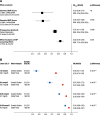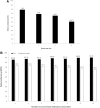Facing the Challenge of Lowering Blood Pressure and Cholesterol in the Same Patient: Report of a Symposium at the European Society of Hypertension
- PMID: 31933276
- PMCID: PMC7237547
- DOI: 10.1007/s40119-019-00159-1
Facing the Challenge of Lowering Blood Pressure and Cholesterol in the Same Patient: Report of a Symposium at the European Society of Hypertension
Abstract
A symposium held at the 29th European Meeting on Hypertension and Cardiovascular Protection in Milan, Italy, discussed the potential impact and long-term benefits of early active management of cardiovascular disease (CVD) risk in patients with hypertension, and potential barriers to this strategy. Hypertension often aggregates with other cardiovascular risk factors, exponentially increasing morbidity and mortality. While effective therapies to treat hypertension exist, a substantial number of patients still experience major cardiovascular events. Two major issues account for these disappointing results: interventions initiated too late in the disease trajectory and lack of effective translation of the research findings into daily clinical practice. Results from genetic studies suggest that lifetime exposure to lower blood pressure (BP) and cholesterol levels due to protective gene mutations, can provide greater cardiovascular benefits than middle-/late-age interventions. Clinical guidelines suggest adding statins to BP-lowering therapies for further cardiovascular benefits in most hypertensive patients; however, real-world data show that physicians' compliance with these recommendations and patients' adherence to BP- and lipid-lowering treatments remain poor, resulting in poor risk factor control and an increased risk of adverse outcomes. The use of single-pill combinations (SPC) can partially mitigate these issues, as they are associated with increased patient adherence and improved BP control. Treatment with SPC has been recommended in the European Hypertension Guidelines, but optimization of the total CVD risk may need adoption of more ambitious treatment strategies aimed to deliver single pills that control multiple CVD risk factors. Amlodipine, perindopril and atorvastatin have been shown to improve BP and lipid levels to a great extent when given separately, and this combination has also been shown to improve cardiovascular outcomes. Overall, early intervention in patients with hypertension with use of an effective, high-intensity cardiovascular risk reduction regimen and attention to medication adherence through reducing pill burden are likely to result in optimal outcomes.
Keywords: Cardiovascular disease; Early intervention; Hypertension; Single-pill combinations; Treatment adherence.
Conflict of interest statement
Stefano Masi was the recipient of the Servier European Grant in Hypertension in 2013 and has received honoraria for speaking activities from Servier. Roland Schmieder received honoraria for speaking and advisory activities from Servier. Bryan Williams has received honoraria for lectures at scientific meetings from Servier. Jacek Wolf received honoraria for speaking activities from Servier.
Figures



References
-
- World Health Organization. Hypertension fact sheet. 2019 [cited 2019 10 July]. https://www.who.int/news-room/fact-sheets/detail/hypertension. Accessed 8 Jan 2020.
-
- GBD Risk Factors Collaborators Global, regional, and national comparative risk assessment of 79 behavioural, environmental and occupational, and metabolic risks or clusters of risks, 1990–2015: a systematic analysis for the Global Burden of Disease Study 2015. Lancet. 2016;388:1659–1724. doi: 10.1016/S0140-6736(16)31679-8. - DOI - PMC - PubMed
-
- Global Burden of Disease Study Collaborators Global, regional, and national incidence, prevalence, and years lived with disability for 301 acute and chronic diseases and injuries in 188 countries, 1990-2013: a systematic analysis for the Global Burden of Disease Study 2013. Lancet. 2015;386:743–800. doi: 10.1016/S0140-6736(15)60692-4. - DOI - PMC - PubMed
-
- World Health Organization. Global atlas on cardiovascular disease prevention and control. 2011 [cited 2019 9 July]; https://www.who.int/cardiovascular_diseases/publications/atlas_cvd/en/. Accessed 8 Jan 2020.
Publication types
Grants and funding
LinkOut - more resources
Full Text Sources

